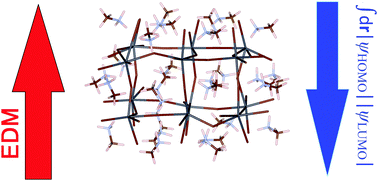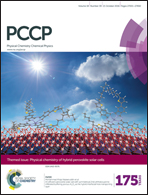Structural and electronic features of small hybrid organic–inorganic halide perovskite clusters: a theoretical analysis†
Abstract
We herein present the results of a series of calculations performed on some representative cluster models of hybrid organic–inorganic halide perovskites, (MA)jPbkXl (l = 2j + k; MA = methylammonium, +CH3NH3; X = halide). In particular, aimed at finding possible analogies with the bulk, we focused our initial attention on neutral clusters of iodides (X = I) constituted by an increasing number of Pb atoms (k = 1, 2, 8, 12). For the single octahedron (k = 1), we similarly extended our calculations to mixed Br-/I-terminated and fully Br-terminated octahedra, finding similar miscibilities for the two dimensionally different systems (i.e., the cluster and bulk). When increasing the size of the models, we found an unequivocally evident relationship between the total dielectric dipole moment of the investigated cluster and the wavefunction spatial distribution of the frontier molecular orbitals. This result rationalizes the structural and electronic properties of such zero-dimensional systems and supports the results previously obtained via linear scaling ab initio methods for very large supercells, i.e., the localization at the nanoscale of the wavefunction of the frontier orbitals as a function of the local fluctuations of the potential, which are mainly associated with the organic cation orientation.

- This article is part of the themed collection: Physical chemistry of hybrid perovskite solar cells


 Please wait while we load your content...
Please wait while we load your content...